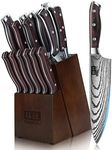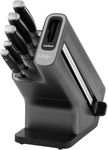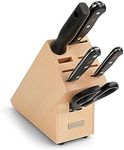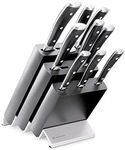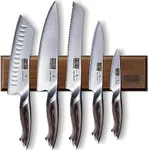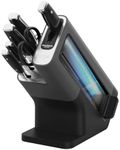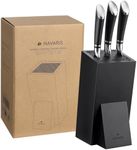Buying Guide for the Best Knife Sets
Choosing the right knife set is essential for any kitchen, whether you're a professional chef or a home cook. A good knife set can make food preparation easier, safer, and more enjoyable. When selecting a knife set, consider the types of knives included, the quality of the materials, and how they fit your cooking style and needs. It's important to understand the key specifications that differentiate one knife set from another to make an informed decision.Blade MaterialThe blade material is crucial as it affects the knife's sharpness, durability, and ease of maintenance. Common materials include stainless steel, carbon steel, and ceramic. Stainless steel is resistant to rust and easy to maintain, making it a popular choice for everyday use. Carbon steel is known for its sharpness and edge retention but requires more care to prevent rust. Ceramic blades are extremely sharp and lightweight but can be brittle. Choose a material based on your willingness to maintain the knives and the type of cooking you do.
Handle MaterialThe handle material impacts the comfort and grip of the knife. Common materials include wood, plastic, and composite. Wooden handles offer a traditional look and feel but may require more maintenance to prevent damage from moisture. Plastic handles are durable and easy to clean, making them a practical choice for busy kitchens. Composite handles combine the benefits of both wood and plastic, offering durability and a comfortable grip. Consider how the handle feels in your hand and how much maintenance you're willing to perform.
Number of PiecesThe number of pieces in a knife set can vary widely, from a basic set of three to a comprehensive set of 15 or more. A basic set typically includes a chef's knife, a paring knife, and a bread knife, which are sufficient for most cooking tasks. Larger sets may include specialized knives like a boning knife, utility knife, or carving knife. Consider the types of meals you prepare regularly and choose a set that includes the knives you will use most often.
Knife ConstructionKnife construction refers to how the knife is made, which affects its balance and durability. Forged knives are made from a single piece of metal and are generally heavier and more balanced, making them ideal for precision tasks. Stamped knives are cut from a sheet of metal and are lighter and more flexible, which can be beneficial for tasks requiring agility. Decide based on your preference for weight and balance in a knife.
Storage OptionsStorage options for knife sets include blocks, magnetic strips, and in-drawer trays. A knife block is a traditional choice that keeps knives organized and easily accessible on the countertop. Magnetic strips save counter space and allow for easy access but require wall space. In-drawer trays keep knives out of sight and safe from dust but may require a dedicated drawer. Consider your kitchen layout and how you prefer to store your knives when choosing a set.
